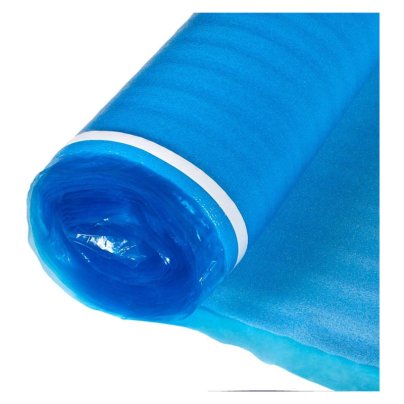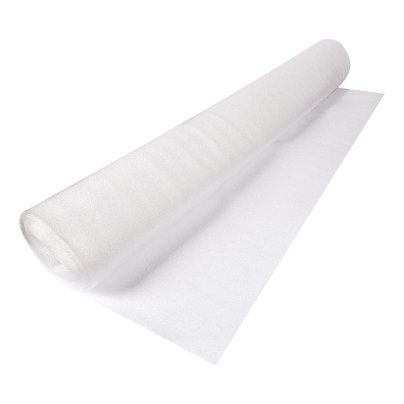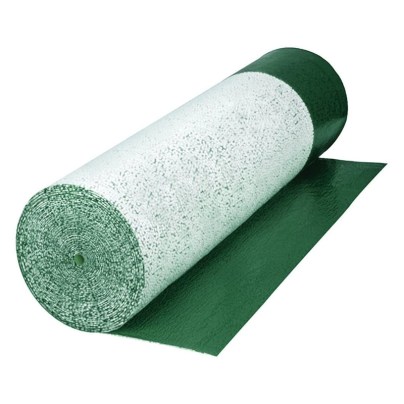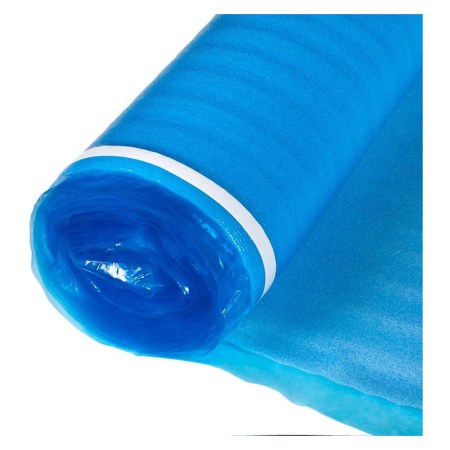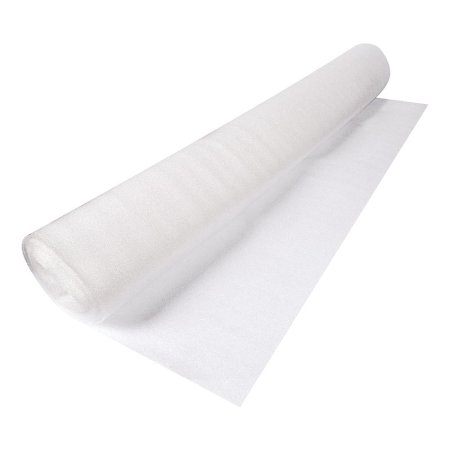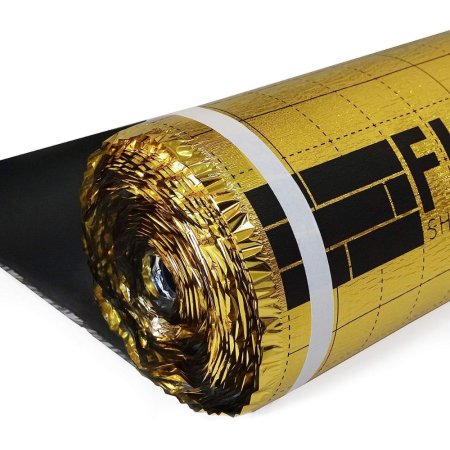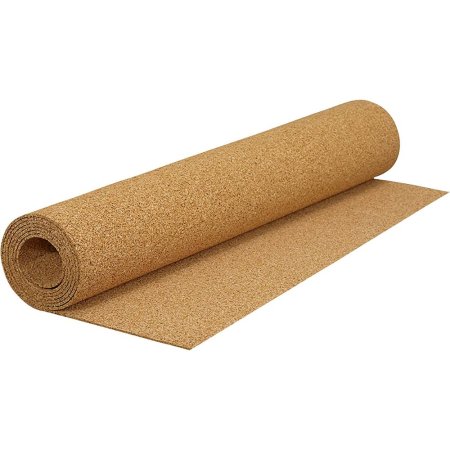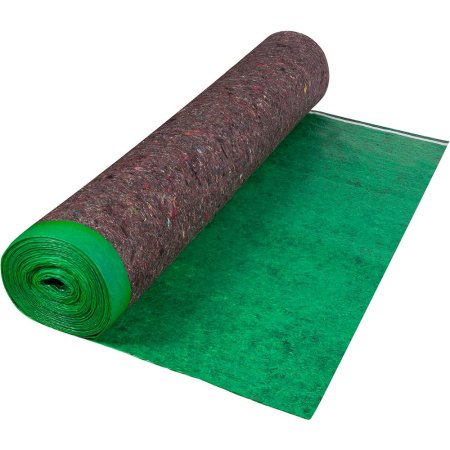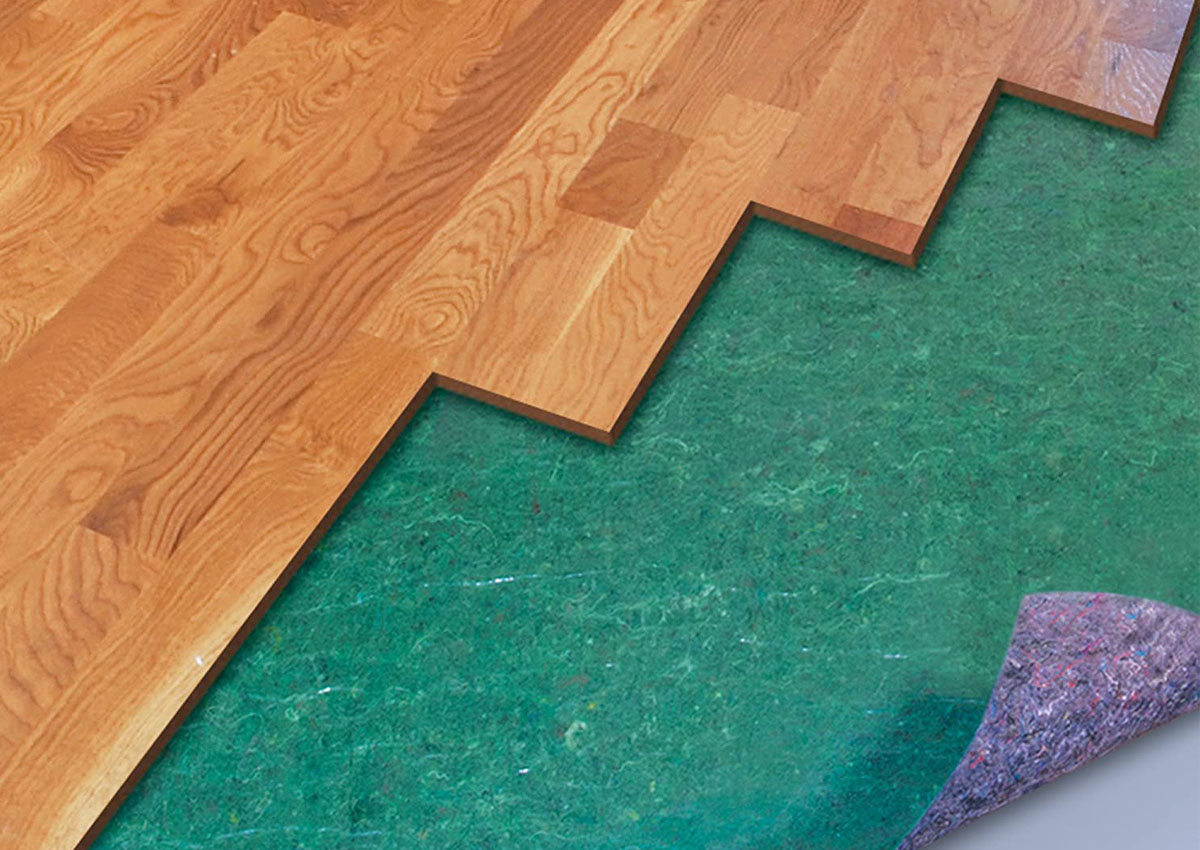
We may earn revenue from the products available on this page and participate in affiliate programs. Learn More ›
Laminate must be installed correctly on top of a quality underlayment, which is key to providing adequate support for the flooring while protecting it from damaging moisture.
Most floor underlayment consists of two layers: a felt layer that provides cushioning and a vapor barrier that protects the flooring from moisture and mold growth. Underlayment also features adhesive tape, which helps connect each strip of laminate, ensuring there are no gaps.
Read on to learn about what features to consider when shopping for the best laminate underlayment and learn why the products below are considered among the best you can use.
- BEST OVERALL: Roberts First Step Premium Underlayment
- BEST BANG FOR THE BUCK: BestLaminate Blue Vapor 3-In-1 Flooring Underlayment
- BEST STANDARD FOAM: Roberts Serenity Foam Underlayment
- BEST COMBINATION: Floorlot GoldMax Premium Flooring Underlayment
- BEST CORK: QEP Natural Cork Underlayment Roll
- BEST FOR NOISE ABSORPTION: Roberts Super Felt Underlayment
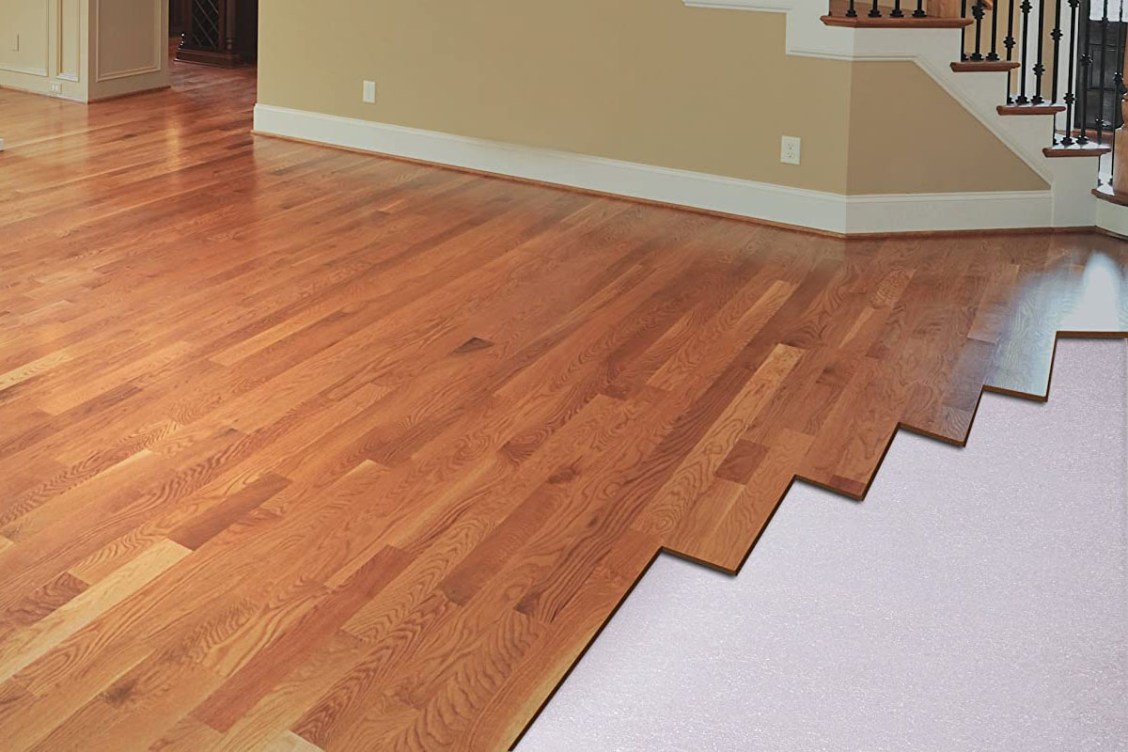
How We Chose the Best Laminate Underlayments
We researched the most sought-after underlayments for laminate floors in their respective categories and discovered that the best options are determined by their type, thermal rating, thickness, sound absorption, compatibility with multiple surfaces and floor types, and other special features included by select brands.
While searching for the best laminate underlayments available, the most popular type among users was the standard foam for their versatility and affordability. While not as popular, the cork and combination options offer ample soundproofing capabilities and thermal insulation, and are easy to install. To ensure our picks are some of the best available, the following underlayment options have 0.15 to 0.59 R-values and 2 millimeter (mm) to 6mm thicknesses for concrete and/or wood subflooring or floating floors.
For ease of installation, the above underlayments are easy to install with built-in self-adhesive tape, ample square footage provided per purchase, vapor and moisture barriers built in, and mold-resistant constructions.
Our Top Picks
Laminate underlayments provide multiple layers to support floating floors and also muffle sound, insulate, and serve as an effective vapor barrier to prevent mold. Each of the underlayment products selected take into account the important considerations discussed below; we’ve also provided a thoroughly vetted list of pros and cons.
BEST OVERALL
Roberts First Step Premium Underlayment
Pros
- Designed for airflow and anti-mold growth, and reduces ambient noise
- 2mm thickness corrects small imperfections and inconsistencies in the subfloor
- 1 roll of underlayment covers 630 square feet of flooring space
- Adhesive strip and 4-inch overlap to help lock out moisture and install easily
Cons
- Only for concrete slabs and wood subfloors on or above grade
Product Specs
- Type: Standard foam
- R-value: 0.432
- Thickness: 2mm
With multiple layers that add protection, comfort, and sound buffering, this product from Roberts is one of the best all-around underlayments for laminate flooring. At the heart of this underlayment is its Styrofoam bead layer, which serves as a cushioning system between the subfloor and underlayment while also leaving space for air movement, helping prevent mold growth. This product is thick enough to correct small imperfections in the subfloor and inconsistencies in the seams.
A vapor barrier protects against moisture. Installation is made easy by a sizable adhesive strip that allows for ample 4-inch overlap, preventing any gaps that could allow moisture through. This underlayment also serves as an effective sound barrier, making it suitable for use on upper floors. Each roll provides 630 square feet of coverage.
Get the Roberts First Step laminate underlayment at Amazon or Walmart.
BEST BANG FOR THE BUCK
BestLaminate Blue Vapor 3-In-1 Flooring Underlayment
Pros
- Suitable for floating floors and subfloors, including concrete and engineered wood subfloors
- 1 roll provides over 100 square feet of coverage; suitable for both small or large spaces
- Self-adhesive strips hold the layer securely and speed up installation
- Vapor barrier built in to help with moisture issues in the home
Cons
- Thinner than comparable options; may provide limited sound insulation
- No R-value listed on the manufacturer’s site
Product Specs
- Type: Standard foam
- R-value: Unlisted
- Thickness: 2mm
With its super-low price and multiple layers, this underlayment from BestLaminate is a square deal. While not as thick as some more expensive underlayments, at 2mm it provides enough cushioning to be a sufficient buffer between floating floors and subfloors. It also includes a vapor barrier, and is suitable for both concrete and wood subfloors.
Built-in self-adhesive strips make installation easy, allowing for a proper overlap between each strip. Keep in mind that its thinner thickness means it won’t have the same sound-damping qualities as other underlayments. As a result, it is better suited for lower floors as opposed to second floors or condos. This underlayment comes in 100-square-foot rolls.
Get the BestLaminate underlayment at Amazon or BestLaminate (bundled).
BEST STANDARD FOAM
Roberts Serenity Foam Underlayment
Pros
- Budget-friendly underlayment is great for covering large areas
- With a built-in moisture barrier, it also is suitable on concrete floors
- Compatible with many floor types, including those with radiant heat
Cons
- Does not include adhesive strips; may slide around during installation
Product Specs
- Type: Standard foam
- R-value: Unlisted
- Thickness: 2.4mm
Homes with wood subfloors might not require a moisture barrier, so this foam underlayment from Roberts is a suitable option. This product, which comes in 100-square-foot rolls, uses a 2.4mm polyethylene foam, which adds cushioning while smoothing out minor imperfections in the subfloor to allow more even laminate flooring installation. It can be used for radiant-heated floors and will work with concrete floors when combined with a vapor barrier.
This underlayment is also nicely priced; but keep in mind it does not include the helpful built-in adhesive strips that make other products easy to install. Each roll is 25 feet long and 4 feet wide.
Get the Roberts Serenity laminate underlayment at Amazon or The Home Depot.
BEST COMBINATION
Floorlot GoldMax Premium Flooring Underlayment
Pros
- Covers more than 200 square feet in a single roll; suitable for small to large spaces
- Extra thick (3mm) to provide great sound absorption from foot traffic and improve small inconsistencies in flooring
- Designed with grid lines, tape, and adhesive for ease of installation
Cons
- Attached installation tape can sometimes be uneven or ineffective
Product Specs
- Type: Combination
- R-value: Unlisted
- Thickness: 3mm
With its three layers, this underlayment provides protection, comfort, and sound absorption, making it one of the best combination underlayments for a floor. It includes a 3mm-thick layer that adds comfort to laminate flooring while helping to level uneven sections and seams in the subfloor.
This thicker layer provides a good insulation barrier, helping bare feet feel more comfortable in the winter, and an excellent sound buffer, which is ideal for upper floors and apartments and condos. With a built-in vapor barrier, this underlayment is suitable for moisture-prone areas.
Peel-and-stick adhesive coupled with a printed grid serves as a guide for lining up the sheets for easy installation A large lip allows for plenty of overlap to prevent gaps between pieces. This underlayment comes in 200-square-foot rolls.
Get the Floorlot laminate underlayment at Amazon, The Home Depot, or Wayfair.
BEST CORK
QEP Natural Cork Underlayment Roll
Pros
- Thicker-than-average underlayment (6mm) provides excellent sound cushioning; suitable for homes with a lot of foot traffic
- Compatible with many kinds of flooring; suitable for main and upper-floor installation
- Comes with a Sound Transmission Class (STC) rating; absorbs a lot of sound compared to other options on this list
- Reduces thermal transmissions to keep floors warmer in the winter
Cons
- Cork material has low moisture resistance compared to other options
Product Specs
- Type: Cork
- R-value: Unlisted
- Thickness: 6mm
With its ample thickness, this cork underlayment serves as an excellent barrier for sound while smoothing over imperfections in the subfloor. Keep in mind that a cork underlayment must be thicker than felt to provide adequate cushioning, but since it isn’t as soft as felt, its additional thickness will still provide the support a floating floor demands. At 6mm thick, this underlayment has an Sound Transmission Class (STC) rating (more on this in the Sound Absorption section below) of 61, which is suitable for upper floors and lower floors.
The product also serves as an insulator, helping to keep the floor warm in the winter while preventing heat loss through the floor. Installation is easy: either lay down or glue down. Its superior thickness also allows this product to resist the transfer of imperfections and cracks from the subfloor to the laminate flooring. This premium cork underlayment comes in 100-square-foot and 200-square-foot rolls.
Get the QEP laminate underlayment at Amazon, The Home Depot, or Wayfair.
BEST FOR NOISE ABSORPTION
Roberts Super Felt Underlayment
Pros
- 3mm thick for thermal insulation and support; impressive R-value helps take the chill out of cold floors
- Comes with 3-inch overlap for complete coverage without any gaps for excellent noise reduction
- 1 roll comes with 360 square feet of coverage; can be used on multiple flooring levels and types
- Made with a moisture barrier that prevents any mold growth from occurring
Cons
- Does not come with adhesive, which makes installation a little trickier
Product Specs
- Type: Combination
- R-Value: 0.58
- Thickness: 3mm
With its superior sound-damping qualities, garnering an impressive STC rating of 66, this thick felt underlayment from Roberts does an excellent job of preventing sound from transferring from upper to lower floors. Since it absorbs noise, this underlayment will also minimize noise in the room and dampen sound traveling to other rooms.
The 3mm-thick underlayment also creates a cushioned feel for laminate flooring and serves as effective insulation as well, keeping the floor warm in the winter. A film overlay adds a moisture barrier that protects the flooring from mold growth. With a built-in 3-inch overlap between pieces, this underlayment is easy to install without creating gaps. One roll should cover 360 square feet.
Get the Roberts Super Felt laminate underlayment at Amazon, The Home Depot, or Wayfair.
Jump to Our Top Picks
What to Consider When Choosing a Laminate Underlayment
Selecting the proper underlayment depends on a variety of factors, the most important being the type of subfloor it will cover. You’ll also want to take the underlayment’s thermal rating, thickness, and sound absorption qualities into account when looking for a viable option for your home.
Types of Laminate Underlayments
Selecting the right type of underlayment is essential to successful laminate flooring installation or removal. Underlayment for laminate flooring comes in three different types, each of which is suited to certain types of subflooring. Keep in mind that some subflooring comes with attached underlayment, in which case you do not need to purchase or install the underlayment.
Standard Foam
True to its name, this type of underlayment for laminate flooring consists of a thin layer of foam that acts as a buffer between the laminate flooring and subfloor. This creates a cushion between the floors that minimizes noise while giving the floor a little more flex for those walking on it. Foam underlayment does not provide a vapor barrier, so it should not be used for damp areas. As such, this type of underlayment is suitable for plywood and oriented strand board (OSB) subfloors.
Combination
Combination underlayment combines a foam layer with a vapor barrier that protects laminate flooring against moisture. The vapor barrier layer on combination foam underlayment allows this type of underlayment to work with concrete subfloors as well as OSB and plywood.
Cork
Cork is a premium underlayment for laminate flooring as it is used to reduce noise. It also has natural antimicrobial properties that prevent mold growth between the laminate flooring and the subfloor. Cork underlayment also provides ample cushioning, is a good insulator, and absorbs sound well. Cork is also significantly more expensive than foam or combination foam underlayment, costing nearly twice as much.
Subfloor Type
The type of subfloor largely dictates what type of underlayment you should use. Underlayment used on a concrete subfloor or floor requires a vapor barrier to prevent moisture from collecting between the subfloor and flooring, which could cause mold growth. Also, consider where the flooring underlayment will be installed.
Types of flooring installed on the upper floor of a home or apartment complex should have underlayment that provides adequate sound buffering to prevent noise from traveling to the floor below.
Thermal Ratings
Pay attention to the underlayment’s R-value, which measures its ability to insulate. The higher the R-value, the better its insulation properties.
Underlayment with a high R-value will keep the floor warmer during cold weather while preventing heat loss through the floor. Likewise, it will help keep conditioned air in the home during warm weather while keeping hot air out. Typical fiberglass insulation found in the exterior walls of houses has an R-value of 3 to 5. Most underlayments have an R-value of 2 or 3.
Thickness
Many DIYers may believe that a thick underlayment will create a more cushioned feel. While this may be the case with carpeting, using a too-thick underlayment material is a mistake with laminate floors. A thick underlayment allows the flooring to flex too much, causing the seams between the boards to separate.
On the other hand, laminate underlayment that is too thin can make the flooring noisy and hard. Felt laminate underlayment should have a thickness of between 2 millimeters and 3 millimeters to provide ample cushioning while still maintaining adequate support for the floor. Cork underlayment is more firm than felt, so it should be about twice as thick in order to provide adequate cushioning.
Sound Absorption
Laminate flooring has the potential to be rather noisy as it flexes against the subfloor. A good underlayment provides a noise-reducing buffer between the two surfaces, preventing annoying creaking sounds. If you live in a condo or apartment, sound absorption is a must to avoid conflict with your neighbors below. In fact, many apartments and condo communities require underlayment that has a minimum sound rating.
Some underlayments have Sound Transmission Class (STC) and Impact Insulation Class (IIC) ratings. STC ratings refer to the material’s ability to block airborne noises, using a scale ranging from 15 to 80, with the higher number being the best. A standard wood floor has an STC rating of about 40.
IIC ratings measure how well material blocks impact noises such as footsteps or furniture that is being moved. Hardwood flooring with no sound insulation has an ILC rating of around 45. Flooring underlayment designed to reduce sound will increase the flooring’s STC and IIC ratings into the 60s.
FAQs
If you still have questions about underlayment thickness, how to install underlayment, or why it’s so important, read on for answers.
Alternative to wood flooring, laminate floors need underlayment that is typically between 2mm and 3mm thick, with 3mm options offering ample cushioning and insulation without compromising the joints between the boards.
Unroll the underlayment making sure that the white adhesive side is faceup. This allows overlapping pieces to connect. If the white adhesive strip is facing down, the underlayment is upside down.
Underlayment is a requirement for laminate flooring. Underlayment allows the floor to float, preventing it from creaking, providing stability, and ensuring the locks between the planks are well supported. Skipping underlayment can actually ruin the flooring.

